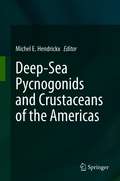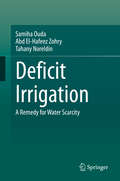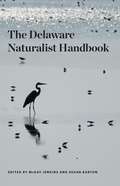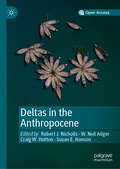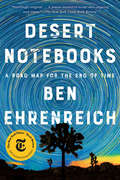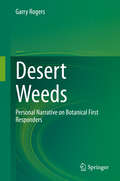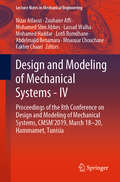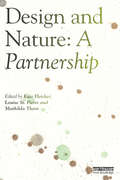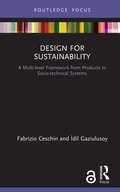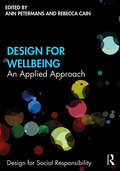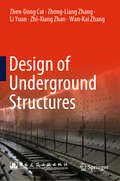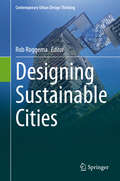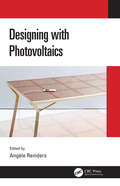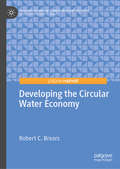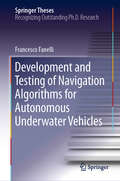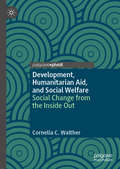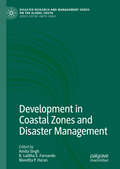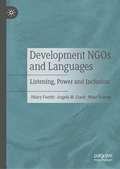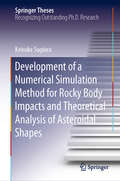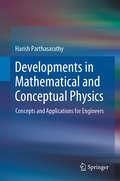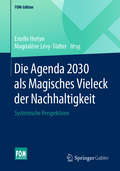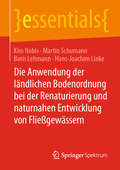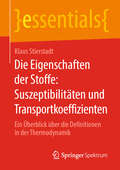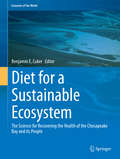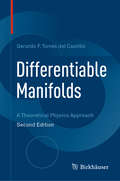- Table View
- List View
Deep-Sea Pycnogonids and Crustaceans of the Americas
by Michel E. HendrickxAmong the deep-sea marine invertebrates, pycnogonids and crustaceans represent ecologically important and most diverse groups of species. Yet both are still poorly understood. Sampling and exploring operations off the west and east coast of the Americas has significantly increased in the last two decades. However such operations are very costly and limited in number and frequency. In countries like Brazil, Canada, Chile, Colombia, Costa Rica, Mexico, Peru, the United States of America, and El Salvador a large effort has been made to explore the deep-sea resources and the rich diversity of the communities, resulting in a better understanding of the natural ecosystems on both coasts of America. Pycnogonids and many groups of deep-sea crustaceans have been intensively studied, from the smallest animals, like the mostly unknown benthic copepods to the largest decapods.This book presents new and updated information on various groups of deep-sea pycnogonids and crustaceans occurring off the American continent. Offering a valuable reference resource for scientists interested in this fascinating fauna, it includes review papers and new data on the deep-sea communities occurring off the USA, Mexico, El Salvador, Costa Rica, Colombia, Chile, Peru, Brazil and Argentina, as well as in larger areas in both the East Pacific and the West Atlantic. As such it covers most of the current deep-water research in Latin America.
Deficit Irrigation: A Remedy for Water Scarcity
by Samiha Ouda Tahany Noreldin Abd El-Hafeez ZohryThis book focuses on proving that deficit irrigation could play an important role in increasing food production in times of water scarcity. Although the application of deficit irrigation can involve loss in crop productivity, it still secures water to be use in cultivating more lands and producing more food. The following questions are discussed and the authors offer solutions to these problems:Will the production, on a national level, resulting from these new added areas compensate yield losses attained by application of deficit irrigation?Is it possible to use deficit irrigation practice to reduce the applied irrigation water to certain crops that have a surplus in their production, and direct this saved water to cultivate new areas with crops have low self-sufficiency ratios? Under climate change in 2030, would deficit irrigation practice have the same role it plays under the current conditions? This book will appeal to students and researchers involved with water scarcity and food security.
The Delaware Naturalist Handbook (Cultural Studies of Delaware and the Eastern Shore)
by McKay Jenkins and Susan BartonThe Delaware Naturalist Handbook is the primary public face of a major university-led public educational outreach and community engagement initiative. This statewide master naturalist certification program is designed to train hundreds of citizen scientists, K–12 environmental educators, ecological restoration volunteers, and habitat managers each year. The initiative is conducted in collaboration with multiple disciplines at the University of Delaware, the University of Delaware Cooperative Extension, the Delaware Environmental Institute (DENIN), the state Department of Natural Resources and Environmental Conservation (DNREC), the state Division of Parks, the state Forest Service, the state Division of Fish and Wildlife, and local nonprofit educational institutions, including the Mount Cuba Center, the Delaware Nature Society and Ashland Nature Center, Delaware Wildlands, Northeast Climate Hub, Center for Inland Bays, and White Clay Creek State Park.
Deltas in the Anthropocene
by Robert J. Nicholls W. Neil Adger Craig W. Hutton Susan E. HansonThe Anthropocene is the human-dominated modern era that has accelerated social, environmental and climate change across the world in the last few decades. This open access book examines the challenges the Anthropocene presents to the sustainable management of deltas, both the many threats as well as the opportunities. In the world’s deltas the Anthropocene is manifest in major land use change, the damming of rivers, the engineering of coasts and the growth of some of the world’s largest megacities; deltas are home to one in twelve of all people in the world. The book explores bio-physical and social dynamics and makes clear adaptation choices and trade-offs that underpin policy and governance processes, including visionary delta management plans. It details new analysis to illustrate these challenges, based on three significant and contrasting deltas: the Ganges-Brahmaputra-Meghna, Mahanadi and Volta. This multi-disciplinary, policy-orientated volume is strongly aligned to the United Nation’s Sustainable Development Goals as delta populations often experience extremes of poverty, gender and structural inequality, variable levels of health and well-being, while being vulnerable to extreme and systematic climate change.
Desert Notebooks: A Road Map for the End of Time
by Ben EhrenreichLayering climate science, mythologies, nature writing, and personal experiences, this New York Times Notable Book presents a stunning reckoning with our current moment and with the literal and figurative end of time.Desert Notebooks examines how the unprecedented pace of destruction to our environment and an increasingly unstable geopolitical landscape have led us to the brink of a calamity greater than any humankind has confronted before. As inhabitants of the Anthropocene, what might some of our own histories tell us about how to confront apocalypse? And how might the geologies and ecologies of desert spaces inform how we see and act toward time—the pasts we have erased and paved over, this anxious present, the future we have no choice but to build? Ehrenreich draws on the stark grandeur of the desert to ask how we might reckon with the uncertainty that surrounds us and fight off the crises that have already begun.In the canyons and oases of the Mojave and in Las Vegas&’s neon apocalypse, Ehrenreich finds beauty, and even hope, surging up in the most unlikely places, from the most barren rocks, and the apparent emptiness of the sky. Desert Notebooks is a vital and necessary chronicle of our past and our present—unflinching, urgent—yet timeless and profound.
Desert Weeds: Personal Narrative on Botanical First Responders
by Garry RogersIn their rapid colonization of soil exposed by fires, floods, and grazing animals, weeds resemble the human specialists we label Emergency Medical Technicians (EMTs). Weeds are the first responders when disasters occur in nature. They occupy bare soil and prevent erosion by wind and water. In extreme cases such as a landslide, weeds are essential to the healing processes that replace the lost soil. Like a Band-Aid on a skinned knee, weeds protect the land while it recovers. Besides protecting the soil after disaster, weeds provide food for wildlife, and some of them provide food and medicine for people. Able to withstand harsh conditions, weeds will proliferate as global warming and other human impacts intensify. Thus, nature’s EMTs will increase while all other plants decline. The book provides a succinct definition of weeds according to their form and function in ecosystem processes. The narrative uses a representative set of weed species from a desert location to illustrate the full range of weed characteristics.
Design and Modeling of Mechanical Systems - IV: Proceedings of the 8th Conference on Design and Modeling of Mechanical Systems, CMSM'2019, March 18–20, Hammamet, Tunisia (Lecture Notes in Mechanical Engineering)
by Mohamed Slim Abbes Fakher Chaari Mohamed Haddar Lotfi Romdhane Abdelmajid Benamara Mnaouar Chouchane Nizar Aifaoui Zouhaier Affi Lassad WalhaThis book offers a collection of original peer-reviewed contributions presented at the 8th International Congress on Design and Modeling of Mechanical Systems (CMSM’2019), held in Hammamet, Tunisia, from the 18th to the 20th of March 2019. It reports on research, innovative industrial applications and case studies concerning mechanical systems and related to modeling and analysis of materials and structures, multiphysics methods, nonlinear dynamics, fluid structure interaction and vibroacoustics, design and manufacturing engineering. Continuing on the tradition of the previous editions, these proceedings offers a broad overview of the state-of-the art in the field and a useful resource for academic and industry specialists active in the field of design and modeling of mechanical systems. CMSM’2019 was jointly organized by two leading Tunisian research laboratories: the Mechanical Engineering Laboratory of the National Engineering School of Monastir, University of Monastir and the Mechanical, Modeling and Manufacturing Laboratory of the National Engineering School of Sfax, University of Sfax.
Design and Nature: A Partnership
by Louise St. Pierre Kate Fletcher Mathilda ThamOrganised as a dialogue between nature and design, this book explores design ideas, opportunities, visions and practices through relating and uncovering experience of the natural world. Presented as an edited collection of 25 wide-ranging short chapters, the book explores the possibility of new relations between design and nature, beyond human mastery and understandings of nature as resource and by calling into question the longstanding role for design as agent of capitalism. The book puts forward ways in which design can form partnerships with living species and examines designers’ capacities for direct experience, awe, integrated relationships and new ways of knowing. It covers: • New design ethics of care • Indigenous perspectives • Prototyping with nature • Methods for new design and nature relations • A history of design and nature • Animist beliefs • De-centering human-centered design • Understanding nature has power and agency Design and Nature: A Partnership is a rich resource for designers who wish to learn to engage with sustainability from the ground up.
Design for Sustainability: A Multi-level Framework from Products to Socio-technical Systems (Routledge Focus on Environment and Sustainability)
by Fabrizio Ceschin İdil GaziulusoyThis book discusses the most significant ways in which design has been applied to sustainability challenges using an evolutionary perspective. It puts forward an innovation framework that is capable of coherently integrating multiple design for sustainability (DfS) approaches developed so far. It is now widely understood that design can and must play a crucial role in the societal transformations towards sustainability. Design can in fact act as a catalyst to trigger and support innovation, and can help to shape the world at different levels: from materials to products, product–service systems, social organisations and socio-technical systems. This book offers a unique perspective on how DfS has evolved in the past decades across these innovation levels, and provides insights on its promising and necessary future development directions. For design scholars, this book will trigger and feed the academic debate on the evolution of DfS and its next research frontiers. For design educators, the book can be used as a supporting tool to design courses and programmes on DfS. For bachelor’s and master’s level design, engineering and management students, the book can be a general resource to provide an understanding of the historical evolution of DfS. For design practitioners and businesses, the book offers a rich set of practical examples, design methods and tools to apply the various DfS approaches in practice, and an innovation framework which can be used as a tool to support change in organisations that aim to integrate DfS in their strategy and processes.
Design for Wellbeing: An Applied Approach (Design for Social Responsibility)
by Ann Petermans Rebecca CainDesign for Wellbeing charts the development and application of design research to improve the personal and societal wellbeing and happiness of people. It draws together contributions from internationally leading academics and designers to demonstrate the latest thinking and research on the design of products, technologies, environments, services and experiences for wellbeing. Part I starts by conceptualising wellbeing and takes an in-depth look at the rise of the design for wellbeing movement. Part II then goes on to demonstrate design for wellbeing in practice through a broad range of domains from products and environments to services. Among others, we see emerging trends in the design of interiors and urban spaces to support wellbeing, designing to enable and support connectedness and social interaction, and designing for behaviour change to tackle unhealthy eating behaviour in children. Significantly, the body of work on subjective wellbeing, design for happiness, is increasing, and several case studies are provided on this, demonstrating how design can contribute to support the wellbeing of people. Part III provides practical guidance for designing for wellbeing through a range of examples of tools, methods and approaches, which are highly user-centric, participatory, critical and speculative. Finally, the book concludes in Part IV with a look at future challenges for design for wellbeing. This book provides students, researchers and practitioners with a detailed assessment of design for wellbeing, taking a distinctive global approach to design practice and theory in context. Design for Wellbeing concerns designers and organisations but also defines its broader contribution to society, culture and economy.
Design of Underground Structures
by Zhen-Dong Cui Zhong-Liang Zhang Li Yuan Zhi-Xiang Zhan Wan-Kai ZhangThis book provides a general review of the literature on underground structures, combined with new specifications, engineering case studies, and numerical simulations based on the authors’ research. It focuses on the basic concepts, theories, and methods of the design of underground structures. After an introduction, it covers various topics, such as elastic foundation beam theory and numerical analysis methods for underground structures, as well as the design of shallow underground structures, diaphragm wall structures, shield tunnel structures, caisson structures, immersed tube structures, and integral tunnel structures. It also includes tables for calculating elastic foundation beam. This book is intended for senior undergraduate and graduate students majoring in urban underground space engineering, building engineering, highway engineering, railway engineering, bridge and tunnel engineering, water conservancy and hydropower engineering.
Designing Sustainable Cities (Contemporary Urban Design Thinking)
by Rob RoggemaThis book emphasizes new ways of designing for a sustainable city and urban environment. From several angles the future of our urbanism is illuminated. From a philosophical point of view, the city is seen as an organism, following complex ecosystemic principles, shining light on indigenous perspectives to become beneficial for sustainable design and core questions are asked whether current architectural practice is really sustainable. Simultaneously concrete practices are presented for cities in transformation, focusing on green infrastructure, smart city principles and health.
Designing with Photovoltaics
by Angèle Reinders"Designing with Photovoltaics" cover a broad range of topics related to the design of products, buildings and vehicles with integrated photovoltaic (PV) technologies including storage aspect. It enables the reader to easily design new products, buildings and vehicles through use of innovative PV products. Diverse categories of product integrated PVs are discussed including applications of solar power for mobility and building integrated systems along with design- and manufacturing-related information about solar cells. Illustrating design cases of various PV-powered products, special attention is paid to end-users and environmental aspects of PV applications. Aimed at senior undergraduates, graduates and professionals in electrical engineering, architecture, design, physics, mechanical engineering and those specifically studying photovoltaics, it Covers the different product integrated photovoltaics (PIPV) with a focus on design and manufacturing Presents comprehensive overview of all aspects of designing with photovoltaics Includes product integrated PV, building integrated PV and solar powered mobility concepts Contains real design cases showing how to design with photovoltaics Discusses context of environmental issues and user aspects
Developing the Circular Water Economy (Palgrave Studies in Climate Resilient Societies)
by Robert C. BrearsThis book presents new research on policy innovations that promote the development of the circular water economy. In contrast to the linear economy, the circular water economy promotes the reduction of water consumption, reuse of water, and recovery of resources from wastewater to not only increase resilience to climate change but also to reduce greenhouse gas emissions resulting from the provision of water and wastewater-related services. Providing a series of in-depth case studies of important locations in differing climates around the globe that have implemented a variety of policy innovations to develop the circular water economy, this book is a valuable resource for water and resource conservation managers, policymakers, international companies and organisations interested in the circular economy, environmental NGOs, researchers, as well as graduate and undergraduate students. · Systematically reviews policy innovations to develop the circular water economy· Illustrates how leading locations from around the world have developed the circular water economy to increase resilience to climate change while reducing emissions · Provides ‘best practices’ for other locations around the world aiming to implement the circular water economy
Development and Testing of Navigation Algorithms for Autonomous Underwater Vehicles (Springer Theses)
by Francesco FanelliThis book focuses on pose estimation algorithms for Autonomous Underwater Vehicles (AUVs). After introducing readers to the state of the art, it describes a joint endeavor involving attitude and position estimation, and details the development of a nonlinear attitude observer that employs inertial and magnetic field data and is suitable for underwater use. In turn, it shows how the estimated attitude constitutes an essential type of input for UKF-based position estimators that combine position, depth, and velocity measurements. The book discusses the possibility of including real-time estimates of sea currents in the developed estimators, and highlights simulations that combine real-world navigation data and experimental test campaigns to evaluate the performance of the resulting solutions. In addition to proposing novel algorithms for estimating the attitudes and positions of AUVs using low-cost sensors and taking into account magnetic disturbances and ocean currents, the book provides readers with extensive information and a source of inspiration for the further development and testing of navigation algorithms for AUVs.
Development, Humanitarian Aid, and Social Welfare: Social Change from the Inside Out
by Cornelia C. WaltherThis book examines how human behavior is shaped by our aspirations, emotions, thoughts and sensations, and conversely, how the experiences that result from our behavior impact ourselves, others and the planet. Based on an analysis of the constant interplay between these four layers, it offers practical solutions to systematically induce sustainable social change dynamics. It shows why change, in addition to economic and political transformation at the macro level, begins with mind-shifts at the micro level. Hereby it establishes the missing link between investments in personal empowerment and collective welfare. A novel theoretical paradigm is the foundation of this book, which is anchored in the perspective of an ongoing ‘body-mind-heart-soul connection.’ Based on the premise that an equitable society is to the benefit of everyone, it is argued that efforts made for others have benefits at three levels – for the individual who acts, the one who has been acted for and for society.
Development in Coastal Zones and Disaster Management (Disaster Research and Management Series on the Global South)
by Amita Singh R. Lalitha. S. Fernando Nivedita P. HaranIn the last two decades, coastal regions have relatively endured some of the fiercest oceanic and geophysical disasters than the earlier decades. Yet, disaster management governance fails to match the human, nonhuman and environmental calamity which is unfolding in its most frequent and unpredictable pattern. Between the Asian Tsunami of 2004 to the devastating Chennai and Kerala floods of 2018 the socio-industrial-livelihood impact alerts governments towards a greater and more serious compliance to laws for coastal conservation. The United Nations Office for Disaster Risk Reduction (UNDRR) in 2018 had shocking statistics to share as the deaths and damages related to only Tsunami disaster at the coasts to 251,770 and US$280 billions respectively in the last 20 years (1998-2017) as compared to 998 and US$ 2.7 billion in the previous 20 years (1978-1997). Coastal conservation is no more a question of casual governance but has become a need for survival. The region of South Asia which ranks much higher in its vulnerability, weak resilience and relatively undersupplied governance structures ought to take this responsibility on a priority. The spirit of Hyogu Declaration and the Sendai Framework for Action suggests preparedness and resilience building as key approach areas in coastal governance. The book is incomparable in its holistic and transdisciplinary social science based approach to disaster management which links conservation of marine flora and fauna, ecosystems and land management with decision making processes and coastal regulations. These grass root findings from the subcontinent are substantiated by a section on the most powerful court battle on the Kerala Floods as a guideline for readers to discerningly identify an ‘Act of God’ often used as a veil to hide lack of preparedness, apathy and political greed. This book becomes indispensable reading for anyone involved in research, administration or any level of decision making for the mitigation and prevention of disasters.
Development NGOs and Languages: Listening, Power and Inclusion
by Hilary Footitt Angela M. Crack Wine TesseurThis book addresses, for the first time, the question of how development NGOs attempt to 'listen' to communities in linguistically diverse environments. NGOs are under increasing pressure to demonstrate that they 'listen' to the people and communities that they are trying to serve, but this can be an immensely challenging task where there are significant language and cultural differences. However, until now, there has been no systematic study of the role of foreign languages in development work. The authors present findings based on interviews with a wide range of NGO staff and government officials, NGO archives, and observations of NGO-community interaction in country case studies. They suggest ways in which NGOs can reform their language policies to listen to the recipients of aid more effectively.
Development of a Numerical Simulation Method for Rocky Body Impacts and Theoretical Analysis of Asteroidal Shapes (Springer Theses)
by Keisuke SugiuraThis book describes numerical simulations of collisions between asteroids, based on a unique numerical code developed by the author. The code accurately solves the elastic dynamic equations and describes the effects of fracture and friction, which makes it possible to investigate the shapes of impact outcomes produced by asteroid collisions and subsequent gravitational accumulation of fragments.The author parallelizes the code with high parallelization efficiency; accordingly, it can be used to conduct high-resolution simulations with the aid of supercomputers and clarify the shapes of small remnants produced through the catastrophic destruction of asteroids. The author demonstrates that flat asteroids can only be produced by impacts involving objects with similar mass and low velocity, which suggests that the flat asteroids in our solar system were created in the planet formation era and have kept their shapes until today. The author also shows that asteroid collisions under certain conditions can produce the extremely elongated shape of an interstellar minor body, 1I/‘Oumuamua. In brief, the book offers a comprehensive investigation of asteroid impacts and shapes, making it a uniquely valuable resource.
Developments in Mathematical and Conceptual Physics: Concepts and Applications for Engineers
by Harish ParthasarathyThis book presents concepts of theoretical physics with engineering applications. The topics are of an intense mathematical nature involving tools like probability and random processes, ordinary and partial differential equations, linear algebra and infinite-dimensional operator theory, perturbation theory, stochastic differential equations, and Riemannian geometry. These mathematical tools have been applied to study problems in mechanics, fluid dynamics, quantum mechanics and quantum field theory, nonlinear dynamical systems, general relativity, cosmology, and electrodynamics. A particularly interesting topic of research interest developed in this book is the design of quantum unitary gates of large size using the Feynman diagrammatic approach to quantum field theory. Through this book, the reader will be able to observe how basic physics can revolutionize technology and also how diverse branches of mathematical physics like large deviation theory, quantum field theory, general relativity, and electrodynamics have many common issues that provide the starting point for unifying the whole of physics, namely in the formulation of Grand Unified Theories (GUTS).
Die Agenda 2030 als Magisches Vieleck der Nachhaltigkeit: Systemische Perspektiven (FOM-Edition)
by Magdalène Lévy-Tödter Estelle HerlynEin Buch zur größten Herausforderung unserer Zeit – der Umsetzung der Agenda 2030 Dieses Buch setzt sich mit der Agenda 2030 und den 17 Sustainable Development Goals auseinander, die – in noch komplexerer Weise als das „Magische Viereck“ der Wirtschaftspolitik – ein Zielsystem mit zahlreichen Wechselwirkungen und Zielkonflikten aufspannen. Das Ziel der Agenda ist es, die Welt in einen Zustand zu bringen, in dem die planetaren Grenzen dauerhaft eingehalten und die Bedürfnisse aller Menschen befriedigt werden. Dabei kann der Zustand des Gesamtsystems anhand von fünf Systemparametern beschrieben werden: Weltbevölkerungsgröße, BIP, Verteilung des Wohlstands, benötigte Ressourcen relativ zur Ressourcenverfügbarkeit und technologischer Fortschritt.Die globale Reichweite der Agenda und verteilte Verantwortungen – von global bis national, über klassische Politikressorts hinweg und nicht zuletzt über verschiedene Akteursgruppen wie z. B. neben der Politik die Unternehmen und die Zivilgesellschaft – erzeugen eine große Komplexität. Das anhaltende Weltbevölkerungswachstum und ungeklärte Finanzierungsfragen stellen weitere große Herausforderungen dar, welche dem Leser erläutert und schließlich anhand einzelner Handlungsfelder und möglicher Lösungsansätze zur Förderung von Entwicklung und internationalem Umwelt- und Klimaschutz konkretisiert werden. Der InhaltLösungsansätze der NachhaltigkeitEinführung in das Magische VieleckUnternehmerische Gemeinschaften und nachhaltige EntwicklungDer Marshall Plan mit Afrika als Ansatz zur Umsetzung der Agenda 2030Anforderungen an nachhaltige Emissionshandelssysteme im Spannungsfeld der Agenda 2030Nachhaltige AgrarwirtschaftAbfall- und Kreislaufwirtschaft im Spannungsfeld der Agenda 2030Nachhaltiger Tourismus in EntwicklungsländernEinblicke in die Analyse der globalen ÄrztemobilitätNachhaltigkeitsziele der Agenda 2030 aus chinesischer PerspektiveNachhaltiger Konsum, Handel und Produktion
Die Anwendung der ländlichen Bodenordnung bei der Renaturierung und naturnahen Entwicklung von Fließgewässern (essentials)
by Boris Lehmann Martin Schumann Kim Nobis Hans-Joachim LinkeDie ländliche Bodenordnung stellt ein wichtiges Instrument zur Bereitstellung und Sicherung der Fläche dar, die für die naturnahe Entwicklung anthropogen veränderter Fließgewässer hin zu eigendynamisch resistenten und resilienten Systemen benötigt wird. In diesem essential geben die Autoren einen Überblick über die Renaturierung und naturnahe Entwicklung von Fließgewässern und die grundlegenden Aspekte der ländlichen Bodenordnung. Die Analyse eines Praxisbeispiels aus Hessen verdeutlicht die Verknüpfung beider Bereiche und ermöglicht so die Entwicklung von Handlungsempfehlungen.
Die Eigenschaften der Stoffe: Ein Überblick über die Definitionen in der Thermodynamik (essentials)
by Klaus StierstadtDieses essential gibt einen Überblick über die Definitionen von Suszeptibilitäten bzw. Responsefunktionen und von Transportkoeffizienten in Materie. Es zeigt, wie Suszeptibilitäten aus thermodynamischen Potenzialen berechnet werden können und wie man Transportkoeffizienten auf die Eigenschaften der Atome zurückführt. Das essential ist Teil einer dreiteiligen Reihe zur Thermodynamik, zusammen mit Temperatur und Wärme – was ist das wirklich? und Thermodynamische Potenziale und Zustandssumme.
Diet for a Sustainable Ecosystem: The Science for Recovering the Health of the Chesapeake Bay and its People (Estuaries of the World)
by Benjamin E. CukerThis book explores a specific ecosystem in depth, in order to weave a story built on place and history. It incorporates the theme of a journey to help reveal the environment-human-health-food system-problem. While drawing on a historical approach stretching back to the American colonial era, it also incorporates more contemporary scientific findings. By crafting its story around a specific place, the book makes it easier for readers to relate to the content, and to subsequently use what they learn to better understand the role of food systems at the global scale.
Differentiable Manifolds: A Theoretical Physics Approach
by Gerardo F. Torres del CastilloThis textbook delves into the theory behind differentiable manifolds while exploring various physics applications along the way. Included throughout the book are a collection of exercises of varying degrees of difficulty. Differentiable Manifolds is intended for graduate students and researchers interested in a theoretical physics approach to the subject. Prerequisites include multivariable calculus, linear algebra, and differential equations and a basic knowledge of analytical mechanics.
